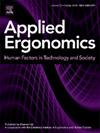Active back exosuits demonstrate positive usability perceptions that drive intention-to-use in the field among logistic warehouse workers
IF 3.1
2区 工程技术
Q2 ENGINEERING, INDUSTRIAL
引用次数: 0
Abstract
Back exosuits offer the potential to reduce occupational back injuries but require in-field acceptance and use to realize this potential. For this study, 146 employees trialed an active back exosuit in the field for 4 h, completing an acceptance usability survey. Comparing the 80% of employees willing to continue wearing this device (N = 117) to those who were not (N = 29) revealed that employees willing to wear this device for a longer-term study generally were more likely to perceive this back exosuit to be effective (helpful) and compatible (minimally disruptive) to their everyday work. Using an optimal tree approach, we demonstrate that intent-to-use could be predicted with 78% accuracy by interacting features of perceived exosuit effectiveness and work compatibility. This study reinforces the importance of task matching, noticeable relief, and unobtrusive design to facilitate short-term employee acceptance of industrial wearable robotic technology.
主动式背部防弹衣显示出积极的可用性认知,推动了物流仓库工人的现场使用意愿。
背部防弹衣具有减少职业性背部伤害的潜力,但需要在现场接受和使用才能实现这一潜力。在这项研究中,146 名员工在现场试用了主动式背部防护服 4 小时,并完成了接受度可用性调查。将 80% 愿意继续穿戴该设备的员工(117 人)与不愿意继续穿戴的员工(29 人)进行比较后发现,愿意长期穿戴该设备进行研究的员工一般更倾向于认为这种背部外衣有效(有帮助)且与他们的日常工作相容(干扰最小)。通过使用最优树方法,我们证明了可以通过感知到的外衣有效性和工作兼容性的交互特征来预测使用意图,准确率高达 78%。这项研究强调了任务匹配、明显缓解和不显眼的设计对于促进员工短期内接受工业可穿戴机器人技术的重要性。
本文章由计算机程序翻译,如有差异,请以英文原文为准。
求助全文
约1分钟内获得全文
求助全文
来源期刊

Applied Ergonomics
工程技术-工程:工业
CiteScore
7.50
自引率
9.40%
发文量
248
审稿时长
53 days
期刊介绍:
Applied Ergonomics is aimed at ergonomists and all those interested in applying ergonomics/human factors in the design, planning and management of technical and social systems at work or leisure. Readership is truly international with subscribers in over 50 countries. Professionals for whom Applied Ergonomics is of interest include: ergonomists, designers, industrial engineers, health and safety specialists, systems engineers, design engineers, organizational psychologists, occupational health specialists and human-computer interaction specialists.
 求助内容:
求助内容: 应助结果提醒方式:
应助结果提醒方式:


